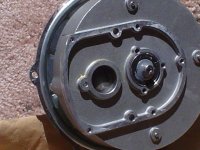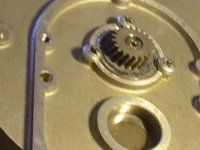rkosiorek
100 kW
what material is the gear made of? is it soft enough to machine? how easy does it file compared to a chunk of steel? if you can file it you can cut it. the same goes for the motor shaft.
most small gears are either made from a sintered metal or a tough steel and not hardened or heat treated. if it is sintered you can probably buy a new metal gear for a few dollars. if it is made from metal you can cut you could always cross drill and drive in a roll pin (some people call them shear pins). is the gear wide enough to take one 3/16" diameter? if you drill into the valley between adjoining gear teeth you should be fine.
a shear pin would probably be enough by itself, but if you insist on overkill you could go with using both the Loctite glue and a shear pin.
rick
most small gears are either made from a sintered metal or a tough steel and not hardened or heat treated. if it is sintered you can probably buy a new metal gear for a few dollars. if it is made from metal you can cut you could always cross drill and drive in a roll pin (some people call them shear pins). is the gear wide enough to take one 3/16" diameter? if you drill into the valley between adjoining gear teeth you should be fine.
a shear pin would probably be enough by itself, but if you insist on overkill you could go with using both the Loctite glue and a shear pin.
rick




